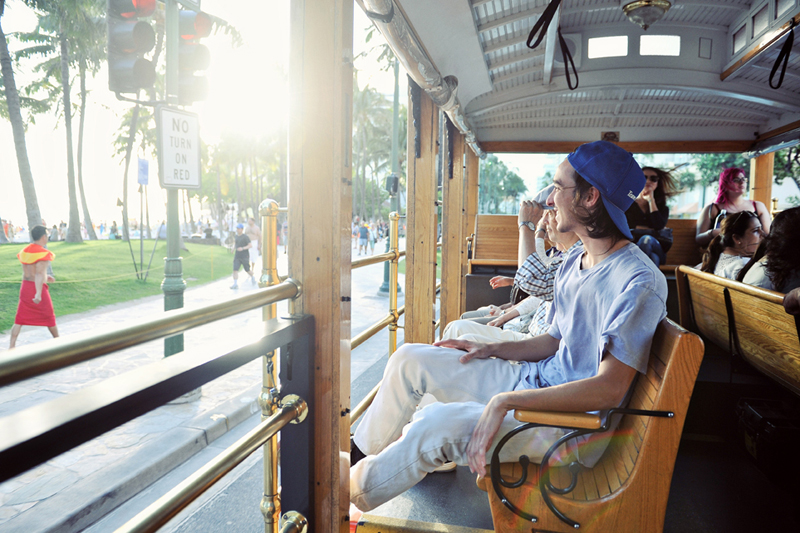Images by John Hook
Waiting to board the Pink Line, a trolley that departs from Ala Moana Center and weaves through Waikīkī with tourists in tow, Drew Broderick looks off into the distance for the next arrival. He is dressed casually, sporting a T-shirt, jeans, and a baseball cap. “The first time I rode on one of these, I remember being so completely overcome with embarrassment,” he recalls jokingly. “But I realized quickly that there’s nothing to be embarrassed about. There’s actually something kind of nice about the anonymity of being on one of these things.”
Once we settle into our trolley seats, the conversation turns to the subject of art. Despite a Spicoli-esque semblance, Broderick is perceptive and quick-witted, with an immense knowledge of art and Hawai‘i, the place he calls home and oft the subject of his artistic pursuits. Broderick is the founder and director of SPF Projects, a new art space in Kaka‘ako dedicated to contemporary art with ties to the islands, but he is also a visual artist in his own right. This year, Broderick was selected to be one of only eleven participating artists in this year’s upcoming Artists of Hawai‘i, a prestigious juried exhibition that takes place biennially at the Honolulu Museum of Art. Much of the artwork he is preparing for the exhibition deals with critical theories surrounding what he calls “paradise economics” (a term referencing the workings of economy in the context of a place like Hawai‘i) and the frustration, desperation, and questions concerning authenticity that stem from it.
Broderick tells me about one piece he’s preparing in particular, which was inspired by two existing pieces in the museum’s collection: Jules Tavernier’s “Sunrise Over Diamond Head” and Lionel Walden’s “Volcano.” Both painters were of the Volcano School, a genre of painting by non-native artists often depicting dramatic nighttime scenes overlooking Hawai‘i’s volcanoes, effectively presenting an idealized version of Hawai‘i.

“I’m interested in the ideology of these romanticized images,” says Broderick. “There’s an interesting connection between that kind of romanticizing of Hawai‘i in art and commerce.” Pinnacle Foods (headquartered in Parsippany, New Jersey), he tells me, is one such company that utilizes this kind of idealism in their marketing tactics. The company’s slogan for their Hawaiian® brand chips reads, “Escape to the islands with the unique taste of Hawaiian-style kettle chips.” Images of smiling hula dancers set against backdrops of erupting volcanoes and glistening beaches adorn the various packages of “Mango Habanero” and “Maui Onion” flavored chips. “There’s a luau barbeque flavor, too,” says Broderick with a laugh. He hopes that his piece in the show will be an attempt at further analyzing this connection and encouraging the younger generations to look past the surface. “There’s a lot to think about here in Hawai‘i. It’s true that artists have thought critically about this place before, but I strongly believe that there’s more to be said. There’s still a lot of work to be done here.”
For Broderick, it’s all about questioning this surface of things. He has an investigative eye that reveals itself in his artwork and ideas. As we make our way through Waikīkī to our final stop, passing various stores, eateries, and merchants on the way, Broderick is quick to point out objects that appear, to my untrained eye, commonplace. The trolley turns onto Saratoga Road, and Broderick leans over the railing. “Look at the post office over there,” he says motioning to the building. “That dry-stack motif was copied and pasted from the kind used in the construction of traditional heiau.” I look on and nod in agreement, impressed by the quick observation. “There are all kinds of origins here that are, for lack of a better term, co-opted and submerged because we’re in a big epicenter for tourism,” he explains. “I find that fascinating. The presence of the material in this context alone is worth contemplating.”

The Lei Maker after Theodore Wores

The Death of Captain Cook after George Carter
Broderick’s work will be on display at Honolulu Museum of Art’s Artists of Hawai‘i 2013, Sept. 19-Nov. 24. For more information, visit honolulumuseum.org. SPF Projects is located at 729 Auahi St., Tue.-Thurs. 7-11 p.m. and Sun. 1-5 p.m.

